Glavel offers a new, low carbon option for builders
Glavel looks nearly identical to crushed stone, but is actually lightweight “foamed glass,” made of 100% recycled material and manufactured in Essex, VT. When used as foundation fill, it provides both drainage and insulation, replacing crushed stone and rigid foam, while outperforming both. Photo courtesy of Juniper Design + Build.
Glavel’s light weight makes it easier to use than crushed stone. Here it is installed via “bulk bag,” where it can be suspended and poured to the needed thickness, rather than dumped from a truck and spread. In addition to being lightweight, Glavel has low embodied carbon and high compressive strength. Photo courtesy of Juniper Design + Build.
industry news
Vermont company rolls out low carbon foam glass gravel product with uses in insulation and drainage
By June Donenfeld
HEADQUARTERED in Burlington, Vermont, Glavel, Inc. rolled out its namesake product in the fall of 2022 at its solar-powered plant in rural Essex, Vermont. Glavel is a lightweight foam glass gravel made of 100% recycled glass for use in construction. It is extremely low in embodied carbon, durable, formaldehyde-free, non-leaching, non-combustible, and resistant to rot, pests, and frost heaves. These puffed-glass, ultra-lightweight thermally insulating nuggets can go by the name of foamed glass aggregate, foam glass gravel, or cellular glass, but whatever they’re called, they can replace both rigid foam board and backfill gravel as insulation and drainage in foundation systems.
Originating in Switzerland decades ago, foam glass is a product that has stood the test of time, and it is an even more welcome option for Maine builders now that it is manufactured nearby. Mark Pollard, co-owner and production director at Juniper Design + Build in Portland, is most excited by the product’s low-carbon aspects. Juniper uses BEAM Estimator, carbon accounting software from Builders for Climate Action, to identify ways to reduce material carbon emissions (MCE) in each of their projects and analyze how much MCE will go into the environment. By using Glavel in the foundation of a recent residential building project on Peaks Island in Portland, Juniper calculated that the CO2e (carbon dioxide equivalent) cost was “6–10 times less than the two next-best choices [would have been.]” Pollard also praised Glavel’s versatility, as it “can be used in the residential and commercial worlds, [for] civil engineering applications requiring a lightweight fill and for lightweight green roof fill, too.”
To learn more about Glavel, visit glavel.com
This article appeared in the Fall 2023 edition of Green & Healthy Maine HOMES. Subscribe today!
Find Maine experts that specialize in healthy, efficient homes in the Green Homes Business Directory.



